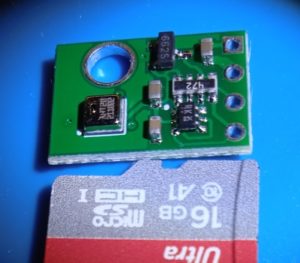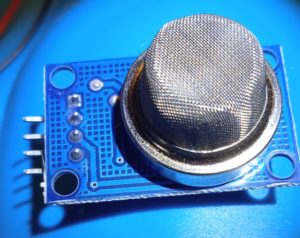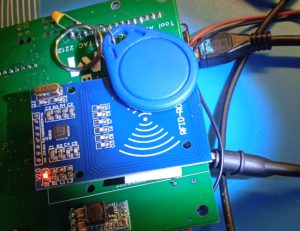Digital Transducers: What?
23rd February 2023
Phil Sorrentino, Contributing Writer, The Computer Club, FL
Computer Input Devices are transducers. They convert the user’s physical actions into commands that the computer can understand and use. Technically speaking, a transducer is a device that converts one form of energy to another form of energy. Energy types being electrical, mechanical, chemical, light, etc.
Transducers are often employed at the boundaries of automation, measurement, and control systems where electrical signals are converted to and from other physical quantities like force, torque, motion, position, etc. The process of converting one form of energy to another is known as transduction. For example, a pressure sensor (transducer) will detect pressure, a mechanical form of energy, and convert it to an analog electrical signal or digital data for display at a remote pressure gauge. But for this discussion, a transducer converts some action in our physical world to digital data to be used by our computer.

Temperature and relative humidity sensor. Cost me less that $2. uSD card for size. Ed.
Also for the purpose of discussion, transducers can be divided into two areas, sensors and actuators. A sensor is used to detect one form of energy and report it in another form (most often an electrical signal). For example, a microphone detects sound energy (pressure differences) and reports it as electrical (analog or digital) signals. An actuator accepts energy and produces movement or an action. The energy supplied to an actuator could be electrical or mechanical. For example, an electric motor and a loudspeaker are both actuators, converting electrical energy into motion for different purposes. (If all is working well, the motor produces rotation and the loudspeaker produces sound.) Some transducers can provide both functions; they might both detect and create action. For example, a typical ultrasonic transducer switches back and forth many times a second between acting as an actuator to produce ultrasonic waves and acting as a sensor to detect the reflected ultrasonic waves. Another example might be a DC motor.
Normally electrical energy rotates the rotor of the motor, but using it another way, rotating a DC electric motor’s rotor will produce electricity (a generator). And, believe it or not, the voice-coil of a speaker can also act as a crude microphone.
The two primary transducers (computer input devices) we currently use are mice (or is that mouses?) and keyboards. But, as you can tell from the large number of smartphones and tablets around, the touch-sensitive screen, or simply touchscreen, is also a very much used input device. A mouse lets the user move a pointer on a display, which allows the user to navigate and inspect the contents of a computer’s file system. The mouse also lets the user launch and interact with programs. The other common device, the keyboard, translates the user’s finger presses or keystrokes into text and commands that let the user interact with programs and perform a variety of functions. The newest transducer, the touchscreen, combines the functions of the mouse and the keyboard and turns finger pressure, location, and motion (gestures) into digital signals which in turn are used to control the smartphone or tablet software and hardware. Other common input devices include a microphone, a scanner, a webcam, a trackball and a trackpad. (There was also a “pointing stick” which I’ve seen on some older Lenovo [used to be IBM] and Dell laptops. If you’ll recall, the pointing stick was a device that was used on a laptop mounted in the keyboard, usually between the G, H and B keys. Applying horizontal pressure on the pointing stick moved the cursor, up down, left, and right. Using the pointing stick was a little tricky, because the velocity of the movement of the cursor was proportional to the pressure applied to the pointing stick. As far as I can see, pointing sticks are not used any more, probably because the trackpad is easier to use, and more than likely, cheaper.)
Newer touchscreens can track the position and motion of more than one finger, sometimes as many as four fingers. These devices can support a wide range of gestures for navigating, launching, and performing other functions. Here are a few multi-finger gestures that can be used with Windows 10: Swipe three fingers up to see all of your open apps; Swipe three fingers down to show the desktop. Other gestures supported by Windows 10 are: Tap on the touchpad to Select an Item; Pinch in or stretch out two fingers to Zoom In or out; Place three fingers on the touchpad and swipe right or left to Switch between open windows.

Methane sensor. Cost less than $2. Ed.
One of the newest transducers being used for control may be one of the oldest transducers around; the microphone. The microphone, which converts voice (changes in air pressure) to digital signals, is being used in Voice Control systems like Cortana in Windows 10. Cortana is an App with which you can use your voice to make a call, send a text message, search the web, or open another App. Cortana can even help you: schedule a meeting, set a reminder, and get up-to-date weather or traffic. (Tap three fingers on a touchpad to open Cortana.)
There are also some specialized input devices like game controllers, graphics tablets, and motion-sensing devices. Microsoft made a motion-sensing device called Kinect, which used a combination of a microphone, video camera, infrared light emitter, and infrared sensors to detect user’s voice commands and motion. .Moving our bodies and speaking is fundamental to our nature, so Microsoft advertised that “Kenect allowed a computer user to interact with the computer without the need for a game controller, through a natural user interface using gestures and spoken commands.” (Note from Microsoft: Manufacturing of the Kenect sensor and adapter has been discontinued, but the Kenect technology continues to live on in products like the HoloLens, Cortana voice assistant, the Windows Hello biometric facial ID system, and a context-aware user interface.)

Keyring tag reader. Cost me under $4. Ed.
Another, not so common, input device is a MIDI keyboard, which is typically a piano-style device used to create and record music by sending music signals over USB to a computer. The MIDI keyboard does not produce sound, but rather the digital signals that it produces from the user’s finger movements are converted to sound in the computer by a software program. There are even some very specialized and very complex input devices used in medical imaging systems. Some of these are computed tomography (CT) scanners, magnetic resonance imaging (MRI) scanners, and positron emission tomography (PET) scanners. All of these specialized devices are designed to convert changes in physical world parameters to digital data in order to let physicians see internal body structures such as tendons, muscles, joints, vessels, and organs beneath the skin to diagnose and treat injuries and illnesses. So, as you can see, transducers play a pretty big role in letting our computers interface to us and our real world.



Recent Comments